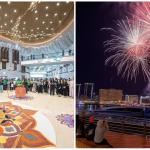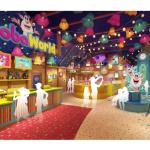Imagine a sprawling metropolis, a vibrant hub of life and commerce, rising from seemingly inhospitable sands. This is Dubai, a testament to human ingenuity and a place where the impossible often becomes reality. While its towering skyscrapers and luxurious lifestyle capture global attention, a quieter revolution has been unfolding beneath the surface: the remarkable science behind greening the desert. Transforming arid landscapes into verdant oases is no small feat, and Dubai’s success story is a fascinating blend of innovative horticulture, cutting-edge technology, and a determined vision to cultivate life in a challenging environment.
At its core, the challenge of greening the desert lies in three primary limitations: water scarcity, extreme temperatures, and nutrient-poor sandy soil. Dubai has tackled these hurdles head-on, pioneering solutions that are not only transforming the cityscape but also offering valuable lessons for arid regions worldwide.
The Lifeline of Green: Innovative Irrigation Techniques
Water, the most precious resource in the desert, is managed with meticulous care in Dubai. Traditional flood irrigation is largely obsolete, replaced by sophisticated and efficient methods that minimize water loss:
- Drip Irrigation: This is the workhorse of Dubai’s greening efforts. A network of pipes delivers water directly to the root zone of plants, significantly reducing evaporation and runoff compared to traditional methods. Sensors monitor soil moisture levels, ensuring that water is only supplied when and where needed, optimizing usage and preventing overwatering.
- Micro-Sprinklers: For larger areas like lawns and ground cover, micro-sprinklers provide targeted irrigation with smaller water droplets, reducing evaporation compared to conventional sprinklers. These systems are often programmed and controlled remotely, allowing for adjustments based on weather conditions.
- Treated Sewage Effluent (TSE): A significant portion of Dubai’s irrigation water comes from treated sewage effluent. This wastewater undergoes rigorous treatment processes to meet stringent safety standards, transforming a potential waste product into a valuable resource for landscaping and agriculture. This reduces the reliance on desalinated seawater for irrigation, conserving energy and reducing environmental impact.
- Hydroponics and Vertical Farming: While still developing on a larger scale for the broader landscape, these soilless cultivation techniques are gaining traction for specific plant production. They offer incredibly efficient water usage by recirculating nutrient-rich water directly to the plant roots in controlled environments.
Taming the Heat: Selecting the Right Flora and Microclimate Management
Dubai’s scorching summers pose a significant challenge for plant survival. The strategy involves selecting plant species that are naturally adapted to arid conditions or have been bred for heat and drought tolerance:
- Native and Drought-Tolerant Species: Landscaping efforts increasingly prioritize native plants that are inherently suited to the local climate. Species like Ghaf trees (Prosopis cineraria), Sidr trees (Ziziphus spina-christi), and various desert shrubs require less water and maintenance once established. Additionally, drought-tolerant non-native species from similar climates around the world are carefully chosen.
- Salt-Tolerant Varieties: Given the use of desalinated water and TSE, some level of salinity can be present in the soil and irrigation water. Selecting salt-tolerant plant varieties is crucial for long-term survival and health.
- Microclimate Creation: To provide more favorable growing conditions, landscape architects and urban planners employ strategies to create microclimates. This includes:
- Shade Provision: Planting trees and installing shade structures reduces direct sunlight and lowers temperatures for more sensitive plants.
- Windbreaks: Carefully placed vegetation or artificial barriers can reduce wind speed, minimizing water loss through transpiration.
- Water Features: While seemingly counterintuitive in a desert, strategically placed water features can create localized cooling effects through evaporation, benefiting surrounding vegetation.
- Green Walls and Roofs: These vertical and rooftop gardens not only add aesthetic appeal but also provide insulation, reducing the urban heat island effect and creating cooler microclimates.
Cultivating Life in the Sands: Soil Improvement and Nutrient Management
The sandy soil prevalent in Dubai is typically low in organic matter and essential nutrients, making it challenging for plants to establish and thrive. Innovative techniques are employed to improve soil structure and fertility:
- Soil Amendments: Large quantities of organic matter, such as composted green waste and manure, are incorporated into the sandy soil. This improves water retention, aeration, and nutrient availability, creating a more hospitable environment for root growth.
- Hydrogels: These super-absorbent polymers are sometimes mixed into the soil. They can absorb and retain large amounts of water, slowly releasing it to the plant roots as needed, thus improving water efficiency, especially during establishment phases.
- Fertilization: Carefully controlled fertilization programs are implemented to provide plants with the necessary nutrients. Slow-release fertilizers are often used to deliver nutrients gradually over time, minimizing leaching and maximizing uptake. Soil testing is crucial to determine the specific nutrient requirements of different plant species and avoid over-fertilization.
- Mycorrhizal Inoculation: Introducing beneficial mycorrhizal fungi to the soil can enhance plant nutrient uptake, particularly phosphorus, and improve drought tolerance by extending the reach of plant roots.
The Role of Technology and Research
Dubai’s greening efforts are heavily supported by technological advancements and ongoing research:
- Smart Sensors and Automation: As mentioned earlier, sensors monitor various environmental parameters like soil moisture, temperature, and humidity, providing real-time data that informs automated irrigation and fertilization systems.
- Remote Monitoring and Control: Landscaping and irrigation systems are often managed remotely through sophisticated software, allowing for efficient monitoring and adjustments.
- Plant Biotechnology and Breeding: Research institutions are exploring and developing plant varieties that are even more resilient to the harsh desert conditions, including improved salt and heat tolerance.
- Data Analytics: Analyzing data collected from sensors and monitoring systems helps optimize resource usage and identify areas for improvement in landscaping practices.
A Sustainable Vision for a Greener Future
Dubai’s commitment to greening its landscape is not merely about aesthetics; it reflects a broader vision of sustainability and environmental responsibility. By embracing innovative horticulture and landscaping practices, the city is:
- Enhancing Quality of Life: Green spaces provide recreational areas, improve air quality, and reduce the urban heat island effect, contributing to a healthier and more livable environment for residents.
- Increasing Biodiversity: Carefully planned landscaping can create habitats for native wildlife, supporting local ecosystems.
- Promoting Sustainable Resource Management: Efficient water usage and the utilization of treated wastewater demonstrate a commitment to responsible resource management in an arid region.
- Inspiring Global Solutions: Dubai’s success story serves as an inspiration and provides valuable insights for other arid and semi-arid regions facing similar environmental challenges.
The transformation of Dubai from a desert landscape to a vibrant green city is a testament to human innovation and perseverance. The science behind this remarkable achievement, encompassing efficient irrigation, careful plant selection, soil improvement, and the integration of technology, offers a compelling example of how even the most challenging environments can be cultivated with knowledge, dedication, and a vision for a greener future. As Dubai continues to grow and evolve, its commitment to sustainable landscaping will undoubtedly play a crucial role in shaping its identity and ensuring a thriving environment for generations to come.










